

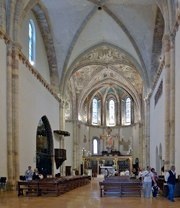
The floor plan of Santa Chiara is modelled on that of the upper church of San Francesco. It served as a church for pilgrims, who (at least initially) could see the chamber in which St Clare was buried through a grill at the front of the altar platform. The nuns of Santa Chiara were not allowed into the church, although they could see the high altar through the grills in the back wall of the right transept that communicated with their cloister.
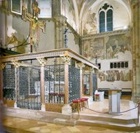
The pergola around the high altar, which is largely in its original form, protected the sacred space from the press of pilgrims. (A similar pergola was installed to protect the high altar in the lower church of San Francesco when the choir screen was removed in ca. 1300, although it was later removed).
There were no lay burials in the church and hence there was no need for burial chapels such as (for example) those that were added in the 14th century to the lower church of San Francesco. Two chapels were however added to the church (see below):
-
✴the Cappella di San Giorgio; and
-
✴the Cappella di Sant' Agnese.
The frescoes that originally covered the walls of the church were whitewashed in 1719 on the orders of Bishop Palmerini, and the surviving fragments were rediscovered only in ca. 1900.
Crucifix (ca. 1260)

The iconography of Christus Patiens (the dying Christ on the Cross) was widely used in early Franciscan churches. In this example, the Virgin and St John the Evangelist flank the Cross, with another figure of the Virgin (praying and flanked by angels) and Christ Pantocrater above. Donna Benedetta is represented with SS Francis and Clare at the foot of the Cross. (Brother Elias had commissioned a similar Crucifix (1235) for San Francesco, in which he was depicted at the foot of the Cross.)
Santa Chiara Dossal (ca. 1283)
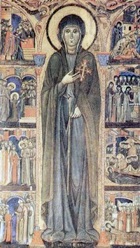
The scenes from the life of St Clare should be read clockwise from the bottom left:
-
✴St Clare receives a palm from Bishop Guido in San Rufino on Palm Sunday of 1211 (or perhaps 1212) before leaving home to embark on her religious life;
-
✴St Francis receives St Clare at the Portiuncula;
-
✴St Clare adopts a religious habit and St Francis cuts her hair;
-
✴St Clare resists her family at San Paolo delle Abbadesse;
-
✴St Agnes (the sister of St Clare) resists her family at Sant Angelo in Panzo and (above) St Francis cuts her hair;
-
✴St Clare multiplies the bread for her sisters at San Damiano;
-
✴the death of St Clare, and her vision of the virgin saints; and
-
✴the funeral of St Clare.
Maestà (ca. 1265)
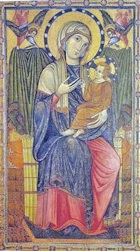
The panel seems to have been painted for a Marian in this transept that Cardinal Enrico Bartolomei di Susa consecrated in 1265. The panel was probably in place at this time.
Frescoes (late 13th century) in the Left Transept
These frescoes are probably the oldest surviving in the church. The best-preserved are those in the top register, which depict (anti-clockwise from the right):
-
✴the creation of the world;
-
✴the creation of Adam;
-
✴the creation of Eve;
-
✴the original sin; and
-
✴the expulsion from Eden.
Other surviving frescoes from the original cycle in this transept depict:
-
✴Noah constructing the ark (right wall);
-
✴the flood (back wall); and
-
✴the sacrifice of Isaac (left wall).

Frescoes (early 14th century)
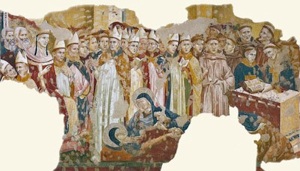
The frescoes in the right transept are the autograph works of the so-called Maestro Espressionista di Santa Chiara, who is named for their expressive style. The surviving scenes depict:
-
✴in the top register:
-
•the Last Judgement (left wall);
-
•Joachim's dream of the imminent birth of the Virgin (back wall); and
-
•the marriage of the Virgin (right wall);
-
✴in the middle register:
-
•the massacre of the innocents and the flight into Egypt (back wall); and
-
•Christ among the doctors (right wall); and
-
✴in the bottom register of the back wall (below the grill that communicates with the cloister):
-
•the funeral of St Clare at San Damiano (illustrated above); and
-
•the translation of her body to Santa Chiara.
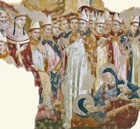
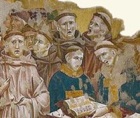
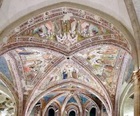
-
✴the Virgin and St Clare;
-
✴SS Agnes of Rome and Agnes of Assisi;
-
✴SS Catherine of Alexandria and Margaret (or Mary Magdalene); and
-
✴SS Lucy and Cecilia.
The fact that St Agnes of Assisi wears a diadem is possibly significant in relation to one of her posthumous miracles, which is reported in the Chronicle of the Twenty Four Generals (search on “Palmerius”): “a certain artist by the name of Palmerius” told the author of the Chronicle and the abbess Balvina of Santa Chiara that his sick brother had been cured after he had prayed to her. In his prayer, he had promised that, should he “happen to paint the image of Agnes, he would add a golden crown above her head”. This supports the suggestion that the Maestro Espressionista di Santa Chiara can be identified as the documented artist, Palmerio di Guido.
Frescoes (1391) on the Left Wall of the Nave
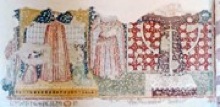
These votive frescoes near the entrance, which are dated by inscription, depict:
-
✴the Madonna della Misercordia;
-
✴an unknown saint; and
-
✴the Volto Santo (Holy Face of Lucca).
Cappella di Sant Agnese (14th century)
This five-sided chapel on the left side of the church was first documented in 1400. It is known that the remains of St Agnes (the sister of St Clare) and other nuns who were originally buried at San Damiano were moved to Santa Chiara in 1257, although it is not known when they were moved to this chapel. Other nuns interred here include:
-
✴Ortulana, the mother of SS Agnes and Clare, who died in 1238 and who was also originally buried at San Damiano; and
-
✴Abbess Benedetta, St Clare's successor.
The grate across the entrance to the chapel is probably original. The original bifore window was re-opened and re-glazed in 1929.
Cappella di San Giorgio (ca. 1270)
The Cappella di San Giorgio is off the right side of the nave.
Crypt
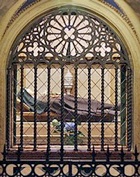

-
✴the grate from San Damiano that covered the opening in the apse through which St Clare and her sisters received the Eucharist, and through which they said their farewell to the dead St Francis in 1226; and
-
✴the original copy of the Rule that Innocent IV approved for St Clare, which is now inserted into the grill.
Historiated Triptych (ca. 1270)
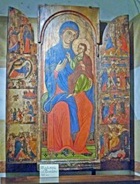
Art from the Church
Crucifixion with Saints (early 14th century)
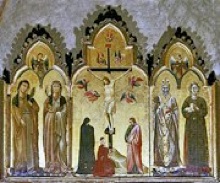
This important triptych, which is attributed to the Maestro Espressionista di Santa Chiara, came from the Cappella di Sant’ Agnese. It depicts:
-
✴the Crucifixion, with the Virgin, St John the Evangelist and a donor:
-
✴SS Clare and Agnes of Assisi (wearing a diadem), on the left; and
-
✴SS Rufinus and Agnes of Rome, on the right.
The polyptych is now in the nunnery.
Miracle of St Clare (14th century)
Both Giorgio Vasari and his contemporary, Fra. Ludovico da Pietralunga, described in glowing terms this now lost panel that was above the grate from which the nuns observed the Mass.
-
✴Vasari attributed the panel to Tommasa di Stefano, Giottino.
-
✴Fra. Ludovico attributed it to Puccio Capanna, and cited the opinions of the artist Dono Doni that:
-
•some of the faces, painted from life, were better than those by Giotto or any other artist of his time; and
-
•the perspectival rendering of a church in the painting was also extraordinarily precocious.
Proceed to the Cappella di San Giorgio.
Return to main page on Santa Chiara.
Return to Walk II.
Return to the home page on Assisi.

